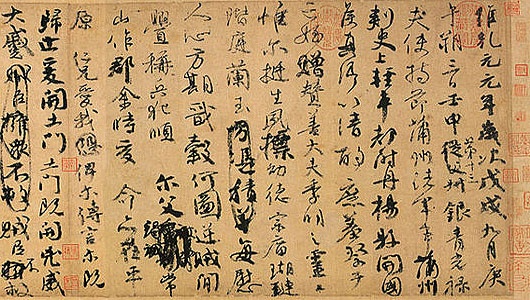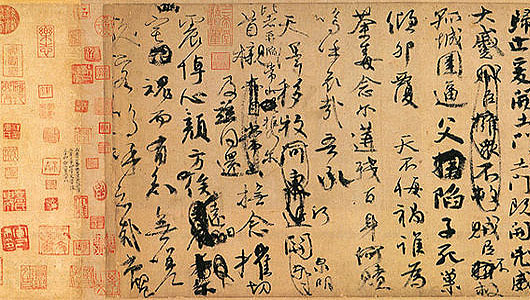Yan Zhenqing (顏真卿): Jiming unokaöcsém dícséretének vázlata 《祭侄文稿》
index | publikációk | facebook oldalunk
In the rebellion of An Lushan (安祿山, 703-757) around 755, Yan Zhenqing’s (顏真卿, 709-785) nephew Yan Jiming (顏季明, 8世紀?-756) was serving in the government of Changshan (常山). The rebel forces invaded the town, the Tang armies did not come to the rescue, resulting in the fall of the town and the death of Jiming. This is what Yan Zhenqing meant when he wrote in this piece, “ Traitorous officials did not rescue them, so the orphaned city was besieged and compelled to submit. The father was taken and the son killed in 756 CE, the nest tipped and the eggs overturned.” After the incident, Yan Zhenqing sent his elder nephew Quanming (泉明) to the town to make funerary arrangements. Only his head of Jiming was found. In 758 CE against these circumstances, Yan Zhenqing at the age of 49 wrote the Draft Euology for Nephew Jiming. His heart was filled with deep sorrow and indignation. Hardly able to restrain himself, he poured love and hatred onto the paper.
The Draft Eulogy for Nephew Jiming (顏真卿 祭侄文稿), handscroll, ink on hemp paper, in running script, 758. The text of the 28.3 x 75.5 cm piece has 234 characters arranged in twenty-three columns. Plus the thirty-four characters Yan himself struck out, the calligraphy has a total of 268 characters. It is kept at the National Palace Museum, Taipei (國立故宮博物院).


The Draft Eulogy for Nephew Jiming (顏真卿 祭侄文稿)
The masterpiece of Yan was regarded as the second best running script in history after Wang Xizhi’s Lanting Xu (Preface to the Orchid Pavilion Collection). But the original of Lanting Xu has been lost. The Draft Eulogy for Nephew Jiming is regarded to be the best running script that survived till today. Yan Zhenqing (顏真卿, 709–785) was a leading Chinese calligrapher and a loyal governor of the Tang Dynasty. He was born in Wan-nian Xian (萬年縣), Jīng zhao fu (京兆府) now Xian (西安), Shanxi (陝西). His ancestors came from Linyi Xian (臨沂縣), Langya Jun (瑯琊郡).
In 734, at the age of 22, Yan Zhenqing qualified from the Imperial Examination and was granted the title of Jinshi (進士). With outstanding academic background, Yan Zhengqing rose rapidly through the ranks. His uprightness and outspoken style angered the corrupted officials. Consequently in 753, he was sent out of the capital as the governor of Pingyuan (平原). During the Anshi Rebellion (安史之亂), Yan was the first to lead his troops in fighting the rebels and thus earned a reputation as a brave and loyal official. His brother Yan Gaoqing (顏杲卿, 692-756) and his nephew Yan Jiming (顏季明, 8世紀?-756) were brutally executed by the rebels.
In 764, Emperor Daizong (唐代宗) conferred the title of Duke of Lu (魯公) on Yan Zhenqing in recognition of his firm loyalty to the government and bravery. In 784 Li Xilie (李希烈, ?-786) rebelled. Yan Zhanqing was sent to negotiate with the rebels. He was also brutally killed by the Li Xilie in 785.
Translation of The Draft Eulogy for Nephew Jiming (顏真卿 祭侄文稿)
維乾元元年,歲次戊戌。
In the inaugural year of Gān yuan, the reign period of Emperor Sùzōng of the Táng Dynasty.
九月庚午,朔三日壬申
On the third, a reshen day, of the ninth month, in which the first was a gengwu day. [9 October 758 CE]
第十三叔,銀青光祿大夫。
His thirteenth uncle, Grand Master of Imperial Entertainments with Silver Seal and Blue Ribbon,
使持節、蒲外諸軍事、蒲州刺史。
Commissioner with Extraordinary Powers Over All Military Affairs in Puzhou, Prefect of Puzhou
上輕車都尉、丹陽縣開國侯真卿
Senior Commandant of Light Chariots, and Dynasty-Founding Marquis of Danyang District, Yan Zhenqing
以清酌庶羞家於亡任贈贊善大夫季明之靈。
With pure wine and a complement of the delicacies, sacrifices to the spirit of Jiming, his late nephew, who was granted the posthumous title of Grand Master Admonisher:
惟爾挺生,夙標幼德。宗廟瑚璉,階庭蘭玉,每慰人心。
From your birth, you showed your youthful virtue early. Like sacrificial vessels in the ancestral temple and fragrant plants in the courtyard, you were a comfort to our hearts.
方期戩谷,河圖逆賊閒釁,稱兵犯順。
In those days, you were blessed and happy. How could we imagined that the rebel traitors would commence our misfortune ? But they took up arms and violated their submission [to the throne].
爾父竭誠,常山作郡。餘時受命,亦在平原。
Your father [Yan Gaoqing] expended his integrity as commandery governor of Changshan, while I, too, had received a mandate at that time, in Pingyuan.
仁兄愛我,俾爾傳言,爾既歸止,爰開土門,土門既開,兇威大蹩。
My selfless older brother so loved me that he asked you to send word to me. You had already returned home and Tumen Pass was conquered; with the opening of Tumen Pass, the villians feared they would be pressed on all sides.
賊臣不救,孤城圍逼。父陷子死,巢傾卵復。
A traitorous official [Wang Chengye] failed the rescue and so the orphaned city was besieged and compelled to submit. The father was taken and the son killed, the nest tipped and the eggs overturned.
天下悔禍,誰為荼毒!
Heaven has no regret for this calamity, but who else could cause such suffering ?
念爾遘殘,百身何贖?嗚呼哀哉!
I remember how you met with your cruel death, but could we ransom all those people. Alas, how I grieve!
我承天澤,移牧河關。泉明比者,再陷至常山,攜爾首櫬,及茲同還。
Since that time, I have been graced with the Beneficence of Heaven and transferred to shepherd the flock on the He-Guan border [Pu-zhou]. After Quanming found me and Changshan was retaken, he retrieved your encoffined head and has now returned together with it.
撫念摧切,震悼心顏!
The memory of your death is revived in me and the shock of grief in my heart and my face is just as it was on that distant day.
方俟遠日,卜爾幽宅。魂而有知,無嗟久客。
I send this announcement to your abode in the nether world, that your spirit may have knowledge of it. Do not weep there long.
嗚呼哀哉!尚饗。
Alas, how I grieve! May you accept this offering.
Contributions of Yan Zhenqing to Calligraphy
Of all the Tang calligraphers, Yan Zhenqing’s style was the most original. His style was a form of liberation from the past. His overriding desire was to impart the maximum power into his strokes – ‘dots like falling stones, horizontals like rain clouds, corners like bent metals, curves like extended bows.’ (豐腴雄渾、柔中帶剛。點畫爽利挺秀、骨力遒勁、結體嚴緊心。) The characters he executed were full of weight, achieved by enclosed forms which had the ideal solidity of the block or the cylinder. In this way he hoped to gain a greater fullness and a more pervasive movement. At the same time, he endowed his characters with an revitalising lustre – the brightness that is so essential to beauty.
Masterpieces like Record of the Duobao Pagoda (多寶塔碑) and Stele of the Yan Family Temple (顏家廟碑) show all this great features of Yan’s calligraphy. His standard scripts have been widely used as the copy books for children and beginners for the last 1250 years. However, they were not written just for children or beginners. Older calligraphers with more experience and expertise can equally appreciate Yan’s standard scripts to the full.

